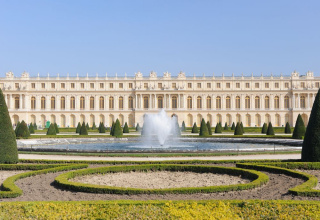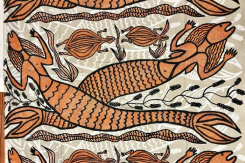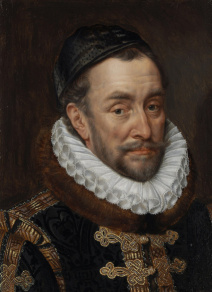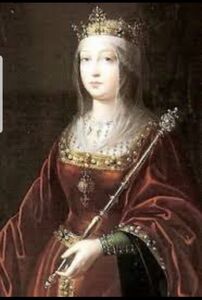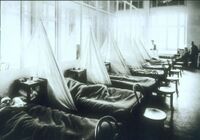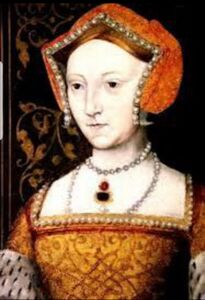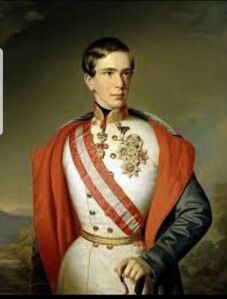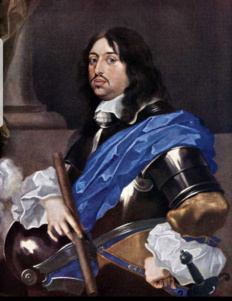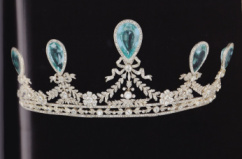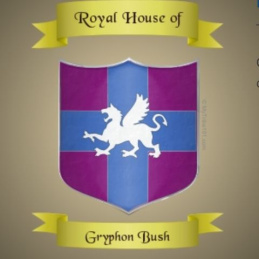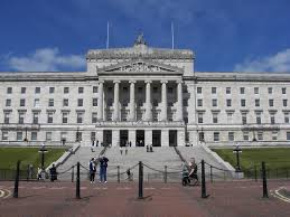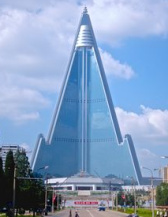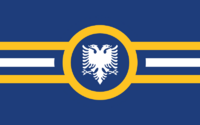West Phoenicia
This article is incomplete because it is pending further input from participants, or it is a work-in-progress by one author. Please comment on this article's talk page to share your input, comments and questions. Note: To contribute to this article, you may need to seek help from the author(s) of this page. |
Confederate Empire of West Phoenicia | |
|---|---|
Anthem: "West Phoenicia in our hearts!" | |
 | |
| Capital and largest city | Melbourne-Haven |
| Official languages | English, West Phoenician |
| Ethnic groups (2020) |
|
| Religion |
|
| Demonym(s) | West Phoenician |
| Government | Federal Parliamentary Constitutional Monarchy |
• Monarch | Emperor Glenton Gryphon-Bush II |
• Prime Minister | Countess Tia High |
• Deputy Prime Minister | Aaron Airè |
| Legislature | Parliament |
| Senate | |
| House of Representatives | |
| Sovereign State | |
• Independence from Greater Phoenicia | 26th January 1586 |
| Area | |
• | 8,024,116 km2 (3,098,129 sq mi) |
| Population | |
• 2019 estimate | 110 million |
| GDP (nominal) | 2020 estimate |
• Total | $6 trillion |
• Per capita | 55,000 |
| Gini | 35.6 medium |
| Currency | The Ba'al |
| Date format | dd-mm-yyyy |
| Driving side | right |
| Calling code | 03 |
| Internet TLD | .wp |
The Empire of West Phoenicia commonly called West Phoenicia, is a sovereign country comprised of 53 City-states, a small number of islands and three external semi-autonomous territories; North Cartier Island Marine Reserve, the Unicorn Isles and Christmastide Island
The nation is surrounded by the Palaven Ocean to west. The Econic Sea to the east. While the Palvonis Strait lies to the north.
The 53 West Phoenician city-states are broken down with 10 provinces within each city-state. The nation uses a multi-party political system that functions as a federal parliamentary constitutional monarchy government. The current Monarch is Emperor Glenton Gryphon-Bush II who has ruled since 2010.
West Phoenicia is located on the continent of Palvaria. The royal family hold almost deity-like status by its citizens.
Melbourne-Haven is the countries capital city, which is also the largest city. Melbourne-Haven is home to the government, The Supreme Court of West Phoenicia and the Imperial Palace.
West Phoenicia covers 8,024,116 sq. km and has has an estimated population of 110 million.
The neighbouring countries to the south-east is Annixe Christos. To the west lies the Commonwealth of Nordhagen
West Phoenicia has a thriving economy that is still heavily agricultural based. It is a member of the World Assembly,and is a member of the Republic of Conservative Nations.
The country plays a role in regional cultural, political, and diplomatic affairs, while citing neutrality on military affairs.
History
Prehistoric History
Archaeologists have theorised that human habitation of the area known as West Phoenicia is believed to have sprung up 7000 to 8000 years ago. Five distinct ethnic groups migrated and flourished throughout the region.
The distinct ethnic groups left their mark through cities, paintings, artifacts and written and oral histories passed down through the generations.
Archeological evidence discovered at a number of sites has shown historians that the Mermania people migrated to the coastal areas of the northern, western and eastern coasts of modern-day West Phoenicia.
Early records showed Mermania settlements consisted of a matriarchal social system. Separated into family bands, led by a female elder.
The Mermania were renowned for their skilled boat making. The skill enabled the clans to focus on fishing.
The clans consumed freshwater and saltwater fish, crab and oysters. The Mermania foraged for seaweed, fruits, nuts and roots to supplement their diets.
Jewellery was produced using pearls and shells. Jewellery was adorned by all members of the tribes and held no monetary or social status.
Due to the close proximity to water, Mermania tribe members were excellent swimmers. Oral history tells that during the Summer months, clans would come together in times of fellowship; at these events, friendly swimming competitions were held.
West Phoenician philosophers and poets have written works about the Mermania tribe descending from Mermaids and Mermen who left the oceans for land when they evolved.
The Desert People, as they are referred to by historians, due to their proximity to the drier harsher territories in the central and southern parts of the region. The Desert People didn't have a singular name, rather each band was identified by their location. The more well-known tribes were "The People of the Mud River" and Desert Fox Clan.
The Desert People were renowned as fierce fighters; especially in hand to hand combat. Land border disputes and access to freshwater supplies placed tribes at odds with each other.
It was common for members of individual tribes to be aggressive towards members of their own tribes when it came to disputes over resources. Disputes were settled in hand to hand combat with the victor inflicting an injury on their opposition.
These hunter and gatherer seasonal nomads would migrate towards warmer locations during the winter months.
The Desert People resided in massive tent cities made from animal hides and wood that protected them from the elements. Desert People women were responsible for putting up and taking down the tents.
Hunting was performed by both genders. Their main sources of diet were animals like rabbits, lizards, snakes and birds. Roots, nuts and other sources of food were obtained through foraging. Foraging was handled by the children.
The tribes were split into family bands with each band controlled by a chieftain who obtained the role from a fight to the death with the previous chieftain.
Hapicuhtli, the double-faceddeity worshipped as their Supreme deity. Hapicuhtli represented Fire and Water. They were Animalistic in general.
Each year tribes held an annual sacrifice of one boy and one girl child to appease their god. One offering was burnt alive to appease the fire. The other drowned to appease the water.
Cave excavations from the late 1800s have shown Dweorg Clans originally resided in the vast mountain ranges to the north at least 7,500 years ago.
It was theorised over time, clans split due to overpopulation.
A sub-group known as the Southern Dweorg migrated away from the mountains to the plains. Dwelling alongside rivers and forests. It opened up new food to these clans. The Southern Dweorgs were among the first to cultivate the land for farming.
Southern Dweorgs suffered huge losses in population. Due to their peaceful nature, they could not compete in fighting off raids from The Babalites and other nomads groups who also resided in the region and were looking to expand. Weaker clans were forced to merge with larger clans or migrate further onto the plains and into the forests to avoid the conflicts.
The Northern Dweorg remained in the mountains and caves. Ir provided a natural defence against raiders and enemy tribes.
Northern Dweorg became skilled in mining and smithing,
Northern Dweorgs became traders, setting up numerous trade routes, trading in minerals, iron and precious gems.
Leadership was in the form of a council of elders; that ruled with the use of wisdom.
Dweorgs worshipped a Supreme deity. Each household had a small alcove for their God that protected them and their home.
Dryadi Tribes lived in vast territories in forests and woods throughout the northern and eastern parts of the region where the temperatures were cooler.
The northern tribes resided in mud lodges on the earth. While the eastern clans settled in the trees in elaborate tree houses. The dwellings allowed the tribes to blend in with their surroundings.
Naturalists at heart they dressed in what they could find in their locations. Leaves, ivy vines, flowers and the furs of deceased animals were popular choices. They would use berries and other sources to dye their hair and faces.
They respected nature and showed care to animals and trees. They were peaceful clans and opposed warfare. However, they practised self-defence, if required to defend themselves
Dryadi tribes lived off the land, consuming fruits, vegetables, nuts; they were primarily vegetarian by nature. However, some tribes would consume the carcass of a dead animal if it meant not starving.
They practised Animism, a belief that all living things have a soul. Tribes were led by a shaman who sought guidance by communicating with the spirits surrounding through trance and divination.
Upon death, tribe members were burnt on funeral pyres. Their ashes mixed with water and poured onto the earth.
The Babalites were a large group of wanderers who upon arrival in the region settled first in the plains. Historians tend to agree they were the last of the five groups to settle in the region.
Within 200 years of settling, they became great horse riders and were skilled in the use of bows and arrows, shields and spears and later swords when iron was introduced to the region through trade and raiding.
To the other ethnic groups in the region, they were commonly referred to as barbarians, due to their warlike nature.
They built established settlements and cities as they expanded. Warriors were sent out on a seasonal basis raiding villages for resources they could not grow or create themselves.
The leadership of each tribe consisted of a Lord or Lady. As time progressed these leaders built fortified castles to protect themselves and their citizens from other Babelite cities.
A hierarchal system was established; farmers and shepherds at the bottom followed by the military, the priest class and finally the nobility class.
Many modern West Phoenicians are predominantly descended from the Babalites.
Civil War within Greater Phoenicia (1570 to 1580)
Before 1586, The Empire of West Phoenicia was under the control of the Greater Phoenicia Empire.
By 1565 dissatisfaction had grown against the Greater Phoenicia Empire and the tyrannical reign of the Dundas family.
Arsinoe I Dundas Virtus; Queen of Greater Phoenicia murdered her husband, King Darius Dundas II with the intent of passing the throne to her son. A backlash erupted from several provinces. Citizens had respected the king and opposed the brutality of his murder.
The Queen and her children were forced to barricade themselves in the palace, with only the palace guards for protection. Reports from witnesses during that period held that many citizens were intent to drag out the queen and murder her. Parts of the palace were set on fire to lure the royal family out.
The riots lasted 7 days. Officials were able to calm the crowds with free grain, food and beer; the bribe worked.
Queen Arsinoe I Dundas Virtus, to appease the crowds declared Prince Darius III as co-ruler with the agreement she would stay on as regent until his 18th birthday.
Within a month, the co-regents advisors convinced him that the Queen was a liability. The advisors feared she would kill King Darius Dundas III and replace him with one of his younger siblings, bestowing her more control. Darius Dundas III was rumoured to have poisoned her based on this advice with the use of deadly nightshade.
King Darius Dundas III was not as benevolent as his father. He drove the farmers to breaking point, taxing farmers 3/4 of their crops. While the lower classes starved, the aristocratic classes had an abundance of food. He drove the nation into debt by his outlandish lifestyle and his policy of raising taxes.
During the winters of 1568 and 1569 thousands of citizens died of starvation, as well as a plague that ravaged the land. Outlining Provinces were taxed heavily to pay for the import of food for people in the cities.
Rebellions sprouted up throughout the provinces. Violence flared against the military who had been dispatched to quash them.
Wealthy churches were ransacked. Members of the aristocracy even protested against King Darius Dundas III and his policies of higher taxes and levies.
King Darius Dundas III and his royalist allies sent out the military to intervene and suppress the rebellions. Citizens fought back, gaining sympathy from more influential people and provinces.
The opposition became more organised under the leadership of local leaders, military members who had defected, sympathetic clergy and members of the aristocracy. King Darius Dundas III branded them rebels and dangerous extremists.
Villages, towns and cities loyal to the rebels were burnt and ransacked.
Enemies of Greater Phoenicia took advantage of the situation by attacking provinces or assisting provinces in attacking government forces and cities. Trade routes affecting the national treasury were also attacked and plundered.
After 10 years of civil strife, diplomats from both sides reached a cease-fire agreement. Those nations who no longer wanted to be part of Greater Phoenicia were free to secede but in doing so were no longer under the protection of Greater Phoenicia.
The War of Greater Phoenicia Aggression (1592 to 1596)
In 1580, after 10 years of a bloody civil war. A number of provinces seceded from the motherland known as Greater Phoenicia.
Initially, each nation set up their own independent state. Conflicts and battles arose as each nation vied for supremacy in the region.
Between 1580 to 1585, meetings known as the Dove of Peace Conferences were held to discuss talks of unity and mutual assistance between a handful of the independent states.
By 1586 ten states agreed to merge into one country which would be named West Phoenicia.
The city of Melbourne Haven in the city-state of Jackson was designated as the nation's capital. The wealthy Dorcas family were appointed as the first royal family of the Kingdom of West Phoenicia in 1586.
From 1586 the nation underwent a massive building campaign. Melbourne-Haven became the centre of government as well as the intellectual and cultural centre of West Phoenicia.
The developing economy revolved around the agriculture sector.
By 1590 another 10 independent provinces petitioned West Phoenicia to unify; all 10 were accepted. This action sparked the War of Greater Phoenicia aggression (1592 to 1596) due to Greater Phoenicia beholding West Phoenicia as a threat to their control of the region.
Greater Phoenicia dispatched troops into nations which were still independent based on information from spies that they aligned or were planning to join West Phoenicia. Military presence was introduced to intimidate them into not merging with West Phoenicia.
Two of those nations, The Kingdom of Debney Bay and The Theocracy of Ardon both fell within 4 months after Greater Phoenicia engaged in a bloody campaign.
Theocracy of Ardon was punished severely for being the first recaptured state that had left the Empire. Cities were burnt to the ground. Those citizens who didn't flee were taken away to become slaves.
The Kingdom of South Phoenicia held out against the blockades of Greater Phoenicia which destroyed their port cities during bombardments. Before assistance could arrive to help the city-state's main cities had been razed to the ground, South Phoenicia surrendered.
The Kingdom of West Phoenicia and other nations that had seceded intervened as best they could. Ambassadors were sent on diplomatic missions, they were murdered before reaching the royal court of King Darius Dundas III.
Troops, food and supplies were sent to The Republic of Imperial Eurasia and The Kingdom of Great Philistia which were being besieged.
.King Darius Dundas III was severe in punishing those nations who had left the Greater Phoenician Empire. Any captured nation was absorbed back into the Empire, where outspoken citizens were rounded up and killed or sent to labour camps.
Diplomats from both sides agreed to an uneasy ceasefire urging for peace for the sake of the region. Soon after calling for a ceasefire the Greater Phoenicia Royal Palace was destroyed in a fire. King Darius Dundas III who was trapped inside, died.
After the death of King Darius Dundas III, his younger brother, Prince Khufu Dundas who sought more peaceful means to end the conflict rose to the throne. Greater Phoenicia reluctantly declared West Phoenicia and the remaining independent city-states to be separate nations and called for an uneasy peace.
Reign of the Dorcas Royal Family (1586-1616)
The Dove of Peace Conferences established West Phoenicia as a nation. The wealthy influential Dorcas family were selected by the nobility and clergy as the first royal family.
The Dorcas family had played an important role in aiding provinces to secede from Greater Phoenicia. Initially they were loyal supporters of the crown until they could see the injustices that were befalling. During the famine years, the family assisted farmers and the poor in there locality to avoid starvation. During the rebellion the family secretly passed resources to aid the rebellion.
During reconstruction an influx of rich and wealthy citizens, merchants and citizens migrated to West Phoenicia boosting the economy with their business.
The Dorcas family under the leadership of KingRichard Dorcas III and Queen Consort Helena Dorcas set the nation of West Phoenicia in a positive direction.
Agriculture sectors started to grow, transforming the cities around them through massive building projects and beautification.
Before the completion of the royal place which was funded by Dorcas finances, the King and Queen were assassinated in 1590 during a harvest festival, the culprit was a Greater Phoenicia supporter.
Greater Phoenicia denied they were involved. The assassin committed suicide before he could reveal who had hired him.
Richard Dorcas III son Prince Constantine I ascended to the throne.
King Constantine Dorcas I led the military during the War of Greater Phoenicia Aggression where he died in battle in 1595 during the Battle of New Tudor
Princess Louisa Dorcas, the only living heir of the late King Richard Dorcas III assumed control of the throne and dealt with the ceasefire with Greater Phoenicia.
After completing the royal palace, major construction moved on to rebuilding all of the city states. Her goal was too make West Phoenicia the envy of the world.
She increased taxes which was not supported by alot of citizens. The money was used to build up the cities that was destroyed during the War with Greater Phoenicia. She constructed harbours and increased trade with neighbours.
New cities, schools, churches and businesses were created under her reign. As well as theatres, arenas, zoos and national gardens. She built statues in all major cities honouring her deceased parents and other heroic figures who had helped form the nation of West Phoenicia.
Queen Louisa Dorcas was criticized by the working class when she bestowed over 3000 nobility titles on the rich and wealthy. To appease the nations poor and working class she increased the number of festivals in West Phoenicia. Days which the working class could take off from their jobs, and supplied with free alcohol, food and entertainment.
Her government advised she marry and secure an heir. It was during this time that the noble family of Bush vied for more power. When the advances of one of the Bush men was not reciprocated rumours begun to pass around that Queen Louisa planned to marry a member of the Greater Phoenicia royal family and unite both nations again.
The Bush family led the charge starting riots across West Phoenicia calling for the Queen and her line to abdicate and pass the throne to a more Pro-West Phoenicia family. When the rumours could not be disproved, members of the church and various nobility sided with the Bush family.
When a church was burnt to the ground by Greater Phoenicia pirates in one of the city-states and Queen Louisa did not step up to act, her popularity and support dwindled. The Bush family organised rallies from all social classes asking for the Queen to step down. The current Pontifex declared the Bush family the new royal family saying it was God's will.
Queen Louisa was prepared to fight for the throne but was advised she needed to do what was best for the country so she abdicated in 1615, where she was given land and made Grand Duchess of West Phoenicia.
Rise of the Bush Royal Family (1616-)
Baron Glenton Bush I became King Glenton Bush I Soter in 1616 after the abdication of Queen Louisa Dorcas. He was 40 at the time of his coronation and was married to Baroness Brenda the elder who became Queen Brenda I Bush Soteria
The titles Soter and Soteria meaning Saviours were bestowed upon them by the church and the citizens.
Many citizens in West Phoenicia believed they had been saved from being united with Greater Phoenicia.
This was the starting of a dynasty which is still on the throne today.
The Royal Family lowered taxes to garnish the support from the poor and working classes,but continued a building campaign that would make West Phoenicia the envy of the world in Science, Philosophy, The Arts and Agriculture.
They married off their children to neighbouring kingdoms to strengthen political alliances through marriage. To keep the royal bloodline pure also encouraged intermarriage of siblings.
Lavender Plague (1628-1632)
The Lavender Plague was a deadly plague that ravaged West Phoenicia between the years of 1628 to 1632.
It began in Deception Bay and was believed to have started from infected sailors and trade merchants who were infected and passed it to the populace. Deeply religious citizens believed it was a curse from God or another diety.
It was dubbed The Lavender Plague due to the lavender colouring that affected and appeared around the eyes and skin of its victims. Other symptoms included high fever, fatigue, severe congestion, swelling and severe diarrhea. Victims usually died from dehydration or infection within 5 days.
By the end of 1632 the Lavender Plague had resulted in the death of 500,000 citizens. Field hospitals were numerous during this time.
It had a high fatality rate among the young, old and infirm.
In 1629, Queen Brenda Bush I also fell victim of the plague as she toured the nation trying to ease the fears of her citizens and to help establish clinics and field hospitals to deal with plague.
Just as suddenly as it appeared, it disappeared.
1st West Phoenicia Civil War (1644-1647)
The First West Phoenician Civil War begun when Queen Bernice Bush II and King August Bush I fought for sole control of the West Phoenician throne.
Both had been named as joint heirs in the will of Queen Bernice Bush I, their mother.
Full blood siblings, they ascended to the throne in 1640 after their mother died in a royal river barge accident.
Bernice Bush II was loved by the people and the Catholics in the nation. She was described as kind, generous and fair. August Bush I, who had spent time in the military as an officer had the support of the military and the Protestants.
While Bernice Bush embarked on a Goodwill tour; August Bush I set out to protect the nation from Greater Phoenicia and The Empire of North Ivoria who had began a aggressive campaign against West Phoenician interests in the region.
During the early period of their marriage they had three children.
A few years into their marriage Bernice Bush II was away from the capital on an extend goodwill tour of West Phoenicia and their allies.
August Bush I began a relationship with Princess Drusilla Bush II; another full blooded sister.
Bernice Bush II opposed the union when she returned. Her husband expressed a desire for a polygamous union. Princess Drusilla Bush II hated her sister and convinced August Bush I that Bernice Bush II was scheming to remove him from the throne.
In defiance he married Drusilla. The siblings fought, August drove his first sister-wife from the throne; replacing her with Drusilla who immediately used her husband's influence with the military to declare war on Bernice and her supporters.
Bernice II and her supporters in government fled to the Kingdom of Gryphon a key ally to regroup and plan a counter attack to restore Bernice II to the throne. .
Catholics in West Phoenicia rebelled and attempted to have August I and Druisilla II removed by staging mass protests.
Protestants fought to keep them on the throne. Both religious groups clashed in bloody conflicts, that left communities damaged and hundreds dead.
The Civil War lasted for three years,with at least eight major battles that saw neither side the victor. A truce was arranged and an agreement was settled.
Under the terms of the truce, Princess Bernice II was to return to West Phoenicia from exile to rule alongside August I and rule all of West Phoenicia jointly as decreed in their mothers Will.
Princess Druisilla who had given birth to Prince August Bush III was demoted to 2nd wife. She was made queen of the Scarlett Orient Isles; an external territory of West Phoenicia to avoid further conflict.
Between 1647 to 1649 there was an uneasy peace between Bernice Bush II and August Bush I. They appeared together for public events and to help pass laws, but each kept different residences.
Princess Drusilla II continued to scheme and poison August I further against his first wife through secret correspondence.
In 1649 he finally had Bernice II poisoned, pinning the blame on The Empire of North Ivoria spies who wanted to fracture the unity of West Phoenicia.
This resulted in 5 years of conflicts between both nations.
West Phoenician Witch Trials (1650-1660)
The Witch Trials began towards the end of the reign of King August Bush I and ended a few years into the reign of Queen Bernice Bush III, his daughter.
In 1650 hysteria surfaced after three years of bad harvests, the faithful blamed the pagan element of the nation, feeling their devotion to foreign gods was causing the One True God to punish them.
A pagan ceremony to call on rain failed. Accusations arose suggesting the blessing was actually a curse and that witches in West Phoenicia were attempting to undermine the nation.
The six witches of the failed rain dance were tried in a district court where Judge Amos Maudy found them guilty.
Three refused to repent, and were further sentenced to death at the stake. The day was called "The Day of the Burning Three"
The day the three were burnt at the stake, the rains came.
The organized religions believed that God had blessed them and to continue receiving the blessing they needed to remove idolatry and witchcraft.
For the next 10 years accusations of witchcraft spread throught the country.
Neighbors accusing neighbors and enemies accused each other.
A list of possible witchcraft crimes was published in each town that feed the hysteria, as neighbours looked at eachother with suspicion.
Many citizens fled the nation in fear. Those citizens accused in the courts and found guilt and who refused to repent were burnt at the stake. Those who did repent were given 10 year sentences. Victims received little legal support and the judges sentenced suspects on the smallest accusations.
Queen Bernice Bush III finally overturned the law when she realised the true purpose of stamping out bad witchcraft and curses had disappeared and people were accusing others out of greed and revenge. She urged those who had fled to return to rebuild areas devastated during the Witch Trials, particularly Selene Valley, Helios Territory and New Egypt.
All in all 50,000 people were burnt at the stake for witchcraft, while a further 100,000 had been sentenced to prison.
2nd West Phoenicia Civil War ( 1711-1713)
Queen Brenda Bush II was ruling West Phoenicia when her Uncle/Huband Domitian Bush I had her murdered so he could be sole ruler.
Civil war broke out when the citizens of West Phoenicia disgusted with what Domitian Bush I had done, supported the son, Prince Richard Bush II right to be her successor.
Domitian Bush I was one of the most brutal rulers West Phoenicia had ever experienced. He ruled with an iron fist for two years, murdering and exiling those who were a threat and burning down villages and towns who aided his enemies. One of the greatest atrocities was the Massacre of Pine Oak, where he had all the children in the town murdered.
At the same time as dealing with vocal opponents, he was fighting a war against his son and his supporters who resided in city-states who were loyal to Brenda Bush II and her children.
There were at least 2 major battles which resulted in countless lives lost.
Domitian Bush I was killed in 1713 by his own senior officers who had tired of the war and saw his death as the only want to end it.
3rd West Phoenicia Civil War (1838-1840)
Tax increases for poor and middle class citizens increased under Queen Elizabeth Bush III; the wife of former king Gaius Bush I who had taken control of the throne after her husband's death. The queen was supported by a small number of government advisors who pushed for her to continue her rule instead of passing it to her son Gaius Bush II; who was next in line for the throne. Under her leadership, her advisors coffers and land allotments grew and she was naive to their scheming.
The poor began to revolt in what became known as the Luxury Tax revolt of 1838. Taxes did not go to the infrastructure or communities but went towards increasing Queen Elizabeth Bush III lavish lifestyle and parties. It was rumoured she had purchased 365 expensive tiaras, one for each day of the year.
The queen was also constantly redecorating Royal palace in the nation's capital and her weekend residence Autumn Brook House
The queens corrupt Minister of the Treasury, Rachel Blackburn convinced her to increase taxes and to exile her son Gaius Bush II who was becoming popular among the citizens with his talks of tax cuts and ambitious social welfare and education programs that would benefit all West Phoenicians.
The plot backfired, many members of the military and clergy flocked to Gaius II Bush, proclaiming him the true King of West Phoenicia.
The queen appointed one of her lovers, Marcus Clerk to the position of General. General Marcus Clerk used the military loyal to the queen quash the rebellions and to help drive her son from West Phoenicia.
Elizabeth Bush III was a weak leader, who took bad advice from inexperienced military strategists. She continuted to lose battles against her son.
Slowly all city-states but the capital had either surrendered or switched alligence to Gaius Bush II.
Without the support of the other city-states, starvation escalated as food was unable to get transported to the capital.
Fearing for their own safety and hopes of clemency from Gaius Bush II who was days away from taking Melbourne-Haven, the inner circle of her Council of Advisors murdered the queen and offered her head on a gold platter as a peace offering.
The death of his mother grieved Gaius Bush II. He entered Melbourne-Haven to a large population celebrating his arrival.
The current Pontifex declared him the King of all of West Phoenicia.
After burying his mother he set about capturing all of the advisors of the Queen's council who had fled and executed them.
A number of advisors escaped and tried to raise a foreign army to invade West Phoenicia. However Gaius Bush II paid money to each of these nations to murder the advisors; payment was given when they sent back the heads as proof.
He stripped all the advisors of the money and property they obtained under the rule of Queen Elizabeth Bush III, selling their families into slavery. He lowered taxes and used the money obtained from the advisor's properties to build up communities that suffered during his mothers reign.
Sinking of the Antebellum Violet (1915)
As World War 1 erupted in Europe. West Phoenicia declared itself neutral.
The Antebellum Violet was a West Phoenician passenger luxury ocean liner; crusing around in international waters, taking in a tour of nearby islands.
On board were 400 First Class Passengers, 600 Second Class passengers and 500 Third Class passengers. 650 crew members were also on board.
On the night of February 14th 1915, a Central Powers U-Boat torpedoed the ocean liner. The Antebellum Violet sunk within 30 minutes. Survivors reported, the ship did not have time to launch roughly half of their lifeboats.
Of the 2150 souls on board 1700 lost their lives.
The attack on the Antebellum Violet created a major backlash in West Phoenicia against neutrality. 80% of the population now favoured declaring war on the Central Powers.
Five days after the sinking West Phoenicia made an official declaration of war and began talks with other allies.
After the sinking Central Powers leaders declared that their own intelligence sources had reported that West Phoenicia had not been so neutral. Claims which were made but never proven suggested The Antebellum Violet was carrying military and diplomats who were enemies to the Central Powers and that the Antebellum Violet had been used as a vessel to transport secret plans of Allied invasions of Central Powers nations.
World War 1 (1914-1918)
The assassination of Franz Ferdinand, the archduke of Austria-Hungary sparked the start of World War 1. West Phoenicia royalists were outraged that two members of a royal household had been assassinated and condemned the actions of the Serbian Nationalist responsible.
West Phoenicia seemed poised to support Austria-Hungary.
However West Phoenicia did not want to be pulled into a war that had nothing to do with them; they declared themselves neutral Both sides were allowed access to the nation on the condition no aggression would be tolerated.
However after the sinking of the Antebellum Violet in 1915 public opinion on neutrality changed. West Phoenicia declared war on the Central Powers.
Central Powers ambassadors were banned from West Phoenicia.
West Phoenicia was not invaded during the war. Their navy encountered a small number of skirmishes against the Central Powers, who engaged in unwanted actions in West Phoenician waters.
Support from Allied nations assisted in defence of their waters and the protection of allied ships travelling in West Phoenician waters.
West Phoenicia assisted with hospital ships, its naval fleet, medicine, food and use of their harbours throughout the rest of the war.
.
150,000 West Phoenicians served the allies in military and citizen capacities.
3000 people were arrested for collaboration with Central Powers during the war.
After World War I ended, West Phoenicia took five years before allowing Central Power ambassadors back into the region.
World War II (1939-1946)
On the outbreak of World War II. The Confederate Kingdom of West Phoenicia initially wished to remain neutral.
It was already at war with the Kingdom of Rhodes The conflict arose due to Prince Alexi Rhodes of the Kingdom of Rhodes who was married to Princess Laodice Bush II, eldest daughter of reining monarch King Tiberius Bush II.
Both plotted and succeed in killing the monarch. King Tiberius Bush II was assassinated by poisoned mushrooms with the intent of claiming the throne.
Popular wife of King Tiberius Bush II, Queen Eurydice Bush, was urged to stay on as queen in her own right due to her popularity. The queen disagreed and stepped down wanting to focus on increasing and assisting in the immigration of people fleeing the Holocaust.
Prince Jarius Bush II assumed control of the throne of West Phoenicia even know he was not next in line, but rather as the Queen's favourite. He immediately declared war on the Kingdom of Rhodes and his sister.
The smaller Kingdom of Rhodes created an alliance with Greater Phoenicia Empire for protection. Reports discovered had both nations forming a friendship pact with Nazi Germany.
Nazi Germany did not engage in war against West Phoenicia, it focused on conquering Europe and Russia. Rather Nazi Germany turned a blind eye to the bombing raids that Greater Phoenicia and The Kingdom of Rhodes committed.
It supplied the two nations with advanced Intelligence reports and the agreement that once West Phoenicia was invaded, a regular tribute of gold, tobacco, cotton and other imports would be handed over to Nazi Germany. All undesirables would be sent to concentration camps.
West Phoenicia suffered from the bombing campaigns of the enemies. West Phoenicia assisted the allies by allowing safe passage in their waters and safe refugee. It allowed allies to dock in their ports for supplies, maintenance and shore leave.
After the attack on Pearl Harbour, West Phoenicia declared war on Japan due to pressure from the United States of America who had allied with West Phoenicia in disrupting Greater Phoenicia and Kingdom of Rhodes ocean trade routes, and attacking enemy naval fleets.
At the height of the war, 80% of the population of West Phoenicia supported the allies in stopping the Axis Powers from taking over the world.
Surprisingly 5% supported the Axis ideals.
In the winter of 1943 the Royal Family retired to the Winter Palace. Spies alerted Greater Phoenicia and the Kingdom of Rhodes, who refocused their bombing campaign on the Winter Palace complex and surrounding cities. One of those bombing campaigns ended with the Winter Palace being bombed and the reigning King Jarius Bush II losing his life to save his family.
West Phoenicia hit back by releasing false intelligence reports that a massive air bombing raid was to be conducted against Greater Phoenicia. It's enemies prepared for the imminent attack.
However, West Phoenicia attacked The Kingdom of Rhodes, shelling their ports and using the West Phoenicia Airforce to bomb the Rhodes capital, government and Military hotspots.
The United States of America navy formed a blockade to stop Greater Phoenicia from sending in assistance. The campaign lasted a month until The Kingdom of Rhodes surrended.
For the remainder of the war West Phoenicia continued to defend itself against Greater Phoenicia and Axis U-Boats.
West Phoenicia also assisted the allies by sending 50,000 troops and 2 Naval fleets against Japan.
War with Empire of North Ivoria (1950-1952)
West Phoenicia held a trade agreement with the Empire of North Ivoria, importing rubies, ivory and sugarcane since the 1800's.
Influential government officials in the Empire of North Ivoria felt West Phoenicia was not contributing enough for their products. Worries also raised were West Phoenicia's sway with the royal family of North Ivoria. There was a fear of an upcoming marriage arrangement that would form a political alliance between the two nations.
Protests flared up in the major cities of North Ivoria, supported by Socialist and Communist organisations. Protestors did not want further West Phoenician influence in their nation, nor a possible future king with West Phoenician blood. By doing trade with West Phoenicia they were missing out on more lucrative deals with Greater Phoenicia, due to West Phoenicia refusing to trade with nations that had trade agreements with their enemies.
In 1949 the Ambassador of West Phoenicia, his wife, two children and their servants were brutally murdered by North Ivoria Nationalists. The same nationalist also murdered the family of the Ambassador from North Ivoria to West Phoenicia.
West Phoenicia pressured the royal family of North Ivoria to arrest and execute the offenders. A West Phoenician delegation flew out to take part in the investigation. North Ivoria government officials refused them entry, an independent North Ivoria investigation would investigate.
When members of the North Ivoria Nationalists were arrested and sentenced. West Phoenicia voiced the sentencing was too lenient.
North Ivoria underwent new elections at the end of 1949 . A new government was installed that featured less pro-West Phoenicia officials who had been reduced to a minority. The new government demanded less West Phoenicia involvement in their nations' policies and wanted more money for their rubies, sugarcane and ivory.
West Phoenicia at the time was exporting tea to The Empire of North Ivoria. North Ivoria Nationalists burnt West Phoenician ships that were in the harbour.
War was declared the day after a North Ivoria Nationalists bombed a military club in West Phoenicia. Killing 5 and injuring 22 and the new government of North Ivoria refusing to assist or investigate.
West Phoenicia's navy created a blockade in North Ivoria waters. Halting trade goods from entering.
The Empire of North Ivoria used guerrilla tactics to attack West Phoenician interests in the region. North Ivoria held out for a year against West Phoenicia naval shelling and its air force bombing campaign. Many nations in the region spoke out against the heavy handed tactics of the West Phoenician military.
The new North Ivoria government exiled the North Ivoria Royal family and other sympathizers. Many fled to West Phoenicia for protection. Only the king remained under house arrest.
The citizens of North Ivoria finally called for new elections feeling the current government had created too much damage, and the nation had suffered under the war.
The hardline anti-West Phoenicia senators were voted out and replaced with more moderate members who were able to orchestrate a peace and trade deal with West Phoenicia and return the exiled royal family.
4th West Phoenicia Civil War (1993-1997)
After the death of Queen Juno in December 1992, Prince Consort Thaddeus Gryphon assumed control of the West Phoenician throne. His duty was a transitional rule, until Princess Aphrilis returned to West Phoenicia, for her coronation. As the late queen's eldest child she was next in line to rule.
Thaddeus's father, Emperor Niclas Gryphon of the Kingdom of Gryphon convinced his son to continue to rule and not hand over the Crown to his eldest step daughter.
The Emperor pledged that the Kingdom of Gryphon would support his son's right to the throne, based on a supposed change in the late Queen Juno's Will which named her child with Prince Consort Thaddeus Gryphon; Prince Glenton Gryphon-Bush II as the next in line for the throne, a promise that was made on his birth, the change would move him ahead of his older siblings.
As his son was a minor, Prince Consort Thaddeus Gryphon would act as Prince Regent until his son turned 18 under the Regency Act 1620
The Kingdom of Gryphon sent a battlion of soldiers to assist in defence.
Emperor Thaddeus Gryphon bribed Most High Reverend Darius Mckay, the reigning Pontifex of the True Path Faith to support his claim to the throne citing it as the will of God.
Thaddeus Gryphon accused Princess Aphrilis and her husband; Crown Prince Christian Sunbury of The Widemeadows Isles of poisoning Queen Juno.
The news of the alleged murder of Queen Juno, who was loved by the population caused the citizens to protest against Princess Aphrilis return.
The West Phoenician government issued a statement banning Princess Aphrilis from returning. However a number of Senators left the country to stand alongside Princess Aphrilis.
Princess Jezebel Tasman-Bush; the second eldest Bush sibling allied with her sister.
Princess Jezebel Tasman-Bush convinced her husband who was a prince of The Kingdom of New Hobart to support a joint military intervention to place Aphrillis on the throne.
Simultaneously, Princess Aphrilis husband persuaded his homeland, The Widemeadows Isles to support Aphrilis rightful claim to the West Phoenician throne. In exchange they would compensate Widemeadows Isles with yearly gold, silver, gems tributes and a free trade agreement.
The other children of Queen Juno were at odds of how to intervene. Prince Gai Bush sided with Prince Consort Thaddeus Gryphon. Princess Clytemnestra, Princess Mariamne and Prince Jericho remained neutral.
After a year of diplomatic talks broke down, the sisters declared war on Thaddeus, West Phoenicia was plunged into a civil war.
The civil war lasted 3 years. In 1996, Thaddeus father, Emperor Niclas passed away from a heart attack. Prince Niclas Gryphon II; the eldest son of Emperor Niclas, and older brother of Thaddeus recalled the Gryphon troops and reduced support for the ongoing conflict.
The reduction of troops, and defection of key government figures and Religious Clergy enabled the sisters to gain the upperhand in the civil war.
Thaddeus who was now acting as Prince Regent was forced to flee to the Kingdom of Gryphon with key supporters, under the protection of his brother.
His son Glenton Gryphon-Bush II who was now 18 was placed under security watch as well as house arrest in the palace when he refused to leave West Phoenicia.
In 1997 he went onto marry Lady Angelique De'Baroda of the Empire of Greater Phoenicia. A marriage alliance that Thaddeus Gryphon had orchestrated to strengthen ties with Greater Phoenicia, in the hope of forming a military alliance.
The elder daughters of late Queen Juno Bush marched into the West Phoenician capital with their foreign armies in 1997 to claim their birthright and thus ended the 4th West Phoenician Civil War.
5th West Phoenicia Civil War (2008-2010)
In the year 2000, Princess Jezebel Tasman-Bush was now queen of West Phoenicia. Historians allege she plotted a stage assassination attempt on her older sister's life to trick her into advocating.
Queen Aphrilis was under the impression from distorted information from intelligence sources within the West Phoenician Security and Security Intelligence Organisation, that the car bombing attack was the work of anti-royalist terrorists.
Aphrilis survived the car bombing attempt. Afraid and not able to control West Phoenicia which was spiralling into anarchy due to the stages terrorist attacks, Aphrilis and her family fled to the Kingdom of Widemeadows Isles, after abdicating the West Phoenician throne. Princess Jezebel who was next in line, became Queen.
Princess Jezebel's coronation was one of the most expensive held coronation held in West Phoenician history. Records indicate it was in the excess of $1.5 million dollars.
Under Queen Jezebel Bush-Tasman leadership and rule, she expanded the nations agriculture industry as well as other industries, boosting the economy.
However governmental financial records during her reign show large amounts of money and resources exported to the Kingdom of New Hobart.
Queen Jezebel filled the ranks of nobility with nobles from her husband's homeland. Giving them land and titles she had stripped from any noble famalies who were in support of her stepfather Thaddeus Gryphon or sister Aphrilis.
She defrocked Most High Reverend Darius McKay of the True Path Faith and sent him into exile. She replaced him with the sycophant Pontifex Mary Macedonia.
Elections were allegedly rigged, allowing those members of Congress that she personally endorsed, winning their electorates. Her allies in the government passed legislation given the queen more authority. The nation leaned closer to an absolute monarchy as opposed to a constitutional monarchy.
Those in government, aristocracy , military or clergy who spoke out against her leadership were either exiled or imprisoned. Other had been reported to have disappeared.
She instructed the Courts to increased the number of people being sentenced to the Prison Labor Program, the added voluntter force increased the production of tobacco, tea, cotton and other resources to be exported.
Citizens began to hate her rule, however protests were quashed.
Prince Glenton Gryphon-Bush II was still under house arrest in one of the royal palaces. By 2008 he had produced seven children with his first wife Princess Angelique. In 1999 he had petitioned his half sister to grant his request of a second marriage due to his polygamous lifestyle, which she granted. A second marriage was arranged between Prince Glenton and Alotta Diesel; a princess from the Kingdom of North Eden.
By 2009 he had four more children by his second wife. She had gifted her half brother and his family Seaxnéat Manor, a large country estate in the city-state of New Tudor. However all members of the household were under close watch and guard.
Queen Jezebel created a large network of spies that kept tabs on disloyal members of the royal household who themselves were exiled or placed under house arrest, if they stepped out of line.
In 2008 intelligence reports reached Queen Jezebel that the Kingdom of Gryphon was going to launch a pre-emptive attack to remove her from the throne. Thaddeus Gryphon was now Emperor of The Kingdom of Gryphon and he was seeking revenge.
She sent a message to Emperor Thaddeus Gryphon that any hostility would see her execute her half brother and his family.
Queen Jezebel's paranoia in trusting those close to her continued to grow. She ordered other family members to be questioned and placed under house arrest. Queen Jezebel feared an imminent attack. Those arrested included her own daughter Princess Servilia Samindia Tasman-Bush on charges of high treason.
Queen Jezebel had the media which was under her control, pushout propaganda, demonising her opponents and the Kingdom of Gryphon.
She arranged for the destruction of tobacco and tea plantations accusing enemies of the destruction.
Queen Jezebel rallied all loyal citizens to rise up against the enemy.
Civil war finally erupted when three innocent tourists from the Kingdom of Gryphon were arrested and executed for espionage without trial under the orders of Queen Jezebel.
Her brother, Prince Gai Bush escaped his own house arrest. He fled to the Kingdom of Gryphon to support his step father. Prince Gai Bush rallied the Kingdom of East Ivoria; his wife's nation of birth to the cause, citing the mistreatment of his wife's at the hands of Queen Jezebel. He was able to sway them to support The Kingdom of Gryphon in the attack on West Phoenicia.
Prince Glenton Gryphon-Bush II second wife Alotta Diesel-Gryphon-Bush used her influence to smuggle out a letter, bribing a guard. The letter was delivered to her father Solomon Diesel; the King of North Eden. The letter persuaded him to join The Kingdom of Gryphon war alliance.
During 2008-2009 Operation Blockade was put into effect by the Tripartite alliance of The Kingdoms of Gryphon, North Eden and East Ivoria. The naval blockade hoped to starve the nation of West Phoenicia by attacking enemy ships and those ships transporting supplies.
The three navy's engaged in shelling of coastal West Phoenician city-state, causing them quickly to surrender.
Following the naval engagements, a combined 3 nation alliance Airforce, bombarded major West Phoenician cities.
The West Phoenician resistance also took up arms, bringing the fight to the streets to free the country from a wicked ruler.
By 2010 the majority of city-states had swung their loyalty to Tripartite alliance.
Queen Jezebel called for a peace treaty at the urging of her advisors and children. Reports had eneny troops were going to be dispatched into Jackson and it's capital Melbourne-Haven.
Fearing execution at the hands of Thaddeus Gryphon and an unsupportable opposing force, Queen Jezebel called for peace on her terms.
The terms were granted.
She was given free passage for her and her family who wanted to depart back to Widemeadows Isles. She would abdicate the West Phoenician throne immediately.
VIctory was declared. Thaddeus Gryphon was only to stay on as a transition rule where he would pass on the throne to his son. Many feared he would refuse to hand it over, however within a month Glenton Gryphon-Bush was installed onto the throne.
Geography
The Empire of West Phoenicia comprisies of 53 City-states and a small number of islands including; North Cartier Island Marine Reserve, the Unicorn Isles and Christmastide Island
North Cartier Island is a marine reserve and wetland roughly 200kms in size, located north of West Phoenicia. It is used by a number of aquatic species, birds and turtles where scientists observe breeding and conduct research. An observation station is located on the island to monitor the fauna in their natural habitat.
Unicorn Isles is a beautiful set of 3 isles that as folklore history tells was an island where a breed of Unicorn lived and flourished. There is something magical about the isles from it's deep mist mornings coming off the bay to its enchanted forests that are filled with fairies, gnomes, elves and giants. The North isle is the most populous with the southern isle having a small population surrounded by flowers, forests, caves and mountain ranges.
It is located on the Palvaria continent.
West Phoenicia covers 8,024,116 sq. km and has has an estimated population of 110 million.
The neighbouring countries to the south-east is Annixe Christos. To the west lies the Commonwealth of Nordhagen
The nation is surrounded by the Palaven Ocean to west. The Econic Sea to the east. While the Palvonis Strait lies to the north.
West Phoenicia has rich fertile land in the north, south and east of the nation. The fertile land is used by agricultural industries to grow tobacco, cotton, coffee and tea.
Gold, silver, emerald and sapphire mines are located in the western regions of the nation along the Mt Ethabaal mountain ranges.
The nations main oil fields are also located in the western regions.
Melbourne-Haven; the West Phoenician capital is located on the east coast. A thriving metropolis of large man made lakes, towering skylines, fancy boutiques, the largest zoo in West Phoenicia and is also the prime centre of government, trade and commerce.
Climate
West Phoenicia has a variety of climates due to its large geographical size.
West coast city-states have mild humid subtropical climates; with the exception of some of the higher elevations in the Mt Ethabaal mountain ranges.
During Autumn and Winter, these mountain ranges experience heavy rainfall without the chill factor.
Throughout Summer, Western city-states transform into a hot arid and semi-arid climate with very little rainfall in the north-west. The south-west coastal portions of the Western city-states have a Mediterranean climate with mild wet winters and hot dry summers.
Northern regions experience more of a mountain temperate climate or a humid continental climate due to its cooler temperatures.
The east and south-east city-states have a more cool temperate climate with large amounts of rainfall especially in Winter and Spring due to large areas being under an oceanic climate.
Summers in West Phoenicia is generally hot and humid, with most of the city-states averaging a high of around 30 degrees during the Summer months.
Winters tend to be mild to very cold for those on the east coast, increasing in coolness at higher elevations.
Mild winter conditions with an early morning chill but mild days tend to occur for the western regions.
East coast city-states tend to have high annual rainfall between April to September. While annual rainfall for the Western city-states tends to occur from April to August.
Fauna
The Empire of West Phoenicia is home to an extensive variety of fauna; including large varieties of introduced species.
Around 390 species of mammals represents the fauna of West Phoenicia. There are more than 100 species of birds and more than 1,000 known species of insects. West Phoenicia also has about 120 known reptiles, 80 amphibians and 100 known fish species.
Among animals that can be found in West Phoenicia include; Nova Texas Buffalo, Polytheisa Heaven Wolf, Red Scorpion, Taipan, Forbidden Marsh Alligator, Lower Bilby, Colony Devil, Lyrebird, Pigeon, Cinnamon Bear, Wild boar, Hedgehogs, The Colony Snow Leopard, Badger, Doves, Birds of Paradise, Seahorse, Phoenician Monarch Butterfly, Mantis, Deception Bay Giant Tortoise, Rattlesnake, New Egypt Cobra and Asp as well as Golden and Blue Poison dart Frogs breeds.
West Phoenician introduced species include; Jackson Plains Zebra, Przewalski horse, Africana Territory Wild Ass, Onyx,
Titania Spider Monkey, Lowlands Africana Territory Giraffe, Okapi, Jackel, Africana Territory Lion, New Dixie Flamingo, Cassowary, Agape Hummingbird,
Yule Island Komodo Dragon, Black Mamba, Green Tree Snake, Glass Frog, Honeybees,
The oceans adjacent to West Phoenicia are filled with a wide array of fish and sea life mammals that include; Dolphin, West Phoenician Tiger Shark, Southern Whale, Octopus, Swordfish, Humpback Whale and West Phoenician Hammerhead Shark and Beluga.
West Phoenicia has over 100 zoological gardens of various sizes. The largest being the West Phoenician National Zoo, located in Jackson and the West Phoenicia International Zoo.
Fifty-three government protected wildlife reserves are spread throughout the nation. The largest reserve is located in Africana Territory. Restricted to the public, the reserves allow animals to live in there natural habitats while at the same time allowing breeding programs and reintroduction to the wild programs.
In addition, West Phoenicia has a host of Aquariums, Sea World Centres, Reptile Houses, Bird Sanctuaries and Butterfly Houses.
Monarchy
The Empire of West Phoenicia has retained a monarchy as their head of State since the unification of city-states in 1586.
The right of a monarchy is outlined in the West Phoenician Constitution
The Constitution also includes the need to keep the monarchy protected from foreign and domestic insurrection.
The Gryphon-Bush Family is the current Royal Family of West Phoenicia that has ruled since 1616.
Prior to the Bush family, The House of Dorcas ruled until they were upsurped by . Glenton Bush I.
After overthrowing the Dorcas royal family, Glenton Bush I was crowned king and started the Bush Dynasty.
Succession
Politics and Government
West Phoenicia is a liberal democratic, federal constitutional monarchy, headed by a sovereign Monarch.
The Monarch retains significant executive powers in the ability to introduce bills and veto bills and approve Senate nominations; however the monarch is bound by the West Phoenician Constitution.
During times when West Phoenicia was dealing with Civil Wars and other incidents, the reigning Monarch has suspended the Constitution and taken full control of the government, however since Emperor Glenton Gryphon-Bush II has been seated on the throne he has supported government initiatives to ensure future monarchs do not have the ability to suspend the Constitution or government.
The royal family is more than a ceremonial Head of State.
The West Phoenician government is separated into three branches; Legislature, Executive and the Judiciary.
The bicameral parliament of The Confederate Empire of West Phoenicia is the legislative branch of the central government that meets in the West Phoenician capital of Melbourne-Haven.
It comprises of the Crown, the Senate and the House of Representatives.
The members of the House represent electoral divisions or districts across West Phoenicia. The members of the Senate, represent the city-states.
The executive is the branch of government exercising authority in and holding responsibility for the governance of West Phoenicia led by a Prime Minister on behalf of the Crown.
The Supreme Court of West Phoenicia and other courts, whose judges are appointed by the Senate on advice of Emperor Glenton Gryphon-Bush II make up the judiciary.
Administrative divisions
The Empire of West Phoenicia comprises of 53 city-states and a handful of external territories.
Each city-state is broken down into 10 provinces/districts.
Political Parties
The Empire of West Phoenicia has a multi party government structure.
The Antebellum Conservative Party is the largest right wing party. They are in an agreement with other center-right parties, calling themselves The Coalition. The Coalition currently holds the majority seats in The House of Representatives and the Senate.
The West Phoenicia Empire First Party is the largest opposition party. It is in a Centrist Union with other centrist parties. The Centrist Union currently hold the opposition government title. However they are losing seats to centre-left and centre-right.
Thirteen political parties are registered with the West Phoenician Electoral Commission at the National, City-State and local levels.
Ministry of Homeland Affairs
The Ministry of Homeland Affairs is the West Phoenician Government interior ministry portfolio with responsibilities for national security, law enforcement, emergency management, border control, immigration, refugees, citizenship, and multicultural affairs
Ministry of Foreign Affairs
The Empire of Phoenicia strives for diplomatic relations with other nations. Believing that open dialogue and diplomacy is the key to peace in the world.
West Phoenicia enjoys good relations with its immediate neighbors on the continent of Galea which it resides with Annixe Christos, The Great Empire of Eldrado and Tesyky
The Empire of West Phoenicia operates embassies across the globe. Many nations have embassies or diplomatic missions in West Phoenicia which are located in five keys areas located across the nation.
On the world stage West Phoenicia is a member of the World Assembly.
Ministry of Justice
The Ministry of Justice is the West Phoenician national government executive ministry created with the responsibility for Justice, Corrections and Law and Order.
Law and Order falls primarily under the resposonsibilty of The West Phoenician National Police Force and The West Phoenician City-state Police Forces.
The Justice component consists of courts and tribunals, composed of judges and justices, who administer justice.
Offenders who are found guilty are than administered by the West Phoenician Corrective Services, in the form of prisons or community based orders and programs.
Ministry of Defence
The Empire of West Phoenicia has an impressive military comprising of;
- West Phoenicia Armed Forces
- West Phoenicia Navy
- West Phoenician Air Force
- West Phoenicia Marine Corps
- West Phoenicia Coast Guard
In addition, there is The West Phoenician Imperial Guard a highly motivated trained unit, whose purpose is the protection the royal family.
All citizens from the age of 18 are conscripted into either The West Phoenician Army, Air force, Navy or Coast Guard for a period service of 4 years for men and 2 years for women.
The West Phoenician Marine Corps does not offer conscription.
Since 1980 combat roles have been available to both genders.
Mandatory retirement age is 60 excluding high ranking military officials which can continue until 70.
Ministry of Trade
West Phoenicia has a strong thriving capitalist mixed economy.
The highly-urbanized capital and eastern coast of West Phoenicia has a high concentration of services-based enterprises and government institutions, while northern, western, and southern areas of the nation are agricultural focused. The Western region is where most mining sites and cattle farms are located.
West Phoenicia has rich fertile land in the north, south and east of the nation which is used for the growing of tobacco, cotton, coffee and tea; major sources of West Phoenician exports.
West Phoenicia has a long history of agriculture being the driven force behind it's booming economy.
Gold, silver, emerald and sapphire mines as well as cattle farms are located in the western regions of the nation along with the nations main oil fields
Ministry of Infrastructure
Energy
West Phoencia's major utilities include a collection of brown-coal-fired power stations located in the western regions that supply energy to the northern, eastern and western regions of West Phoencia.
Southern regions of West Phoenicia rely 50% on brown coal and 50% on alternative energy schemes such as wind farms and solar power. Alternative energy schemes are implemented to reduce the carbon emission and reliance on brown coal.
Water
West Phoenician water infrastructure includes a series of dams and reservoirs, predominantly in Central West Phoenicia that holds and collect water for much of the nation.
The water collected is of a very high quality and requires little chlorination treatment, giving the water a pristine pure taste.
The West Phoencia Water Grid consists of a number of new connections and pipelines being built across the nation. This allows water to be moved around West Phoencia to where it is needed most and reduces the impact of localized droughts in an era thought to be influenced by climate change.
In the city-states of New Rome and New Egypt vast mega modern aqueducts exists to assist in non city areas containing fresh water.
Transport
The West Phoenician road network services the population centres, with highways radiating from Melbourne-Haven to all major cities and rural centres with secondary roads interconnecting the highways to each other.
Public Transport All populated capital cities and outlining suburbs have an extensive train, trams and bus services run by private operators. Train and tram services in all major cities are run 24 hours a day.
Rural areas are connected by public and private bus services and run 24 hours a day.
Airlines
West Phoenicia first airline was established in the early 1920s.
West Phoenicia has many airports both for passengers and freight transport. Each city-state has at least one regional airport.
The West Phoenician airline industry is administered by the Minister of Transportation, Aviation and Innovation. The current minister is James Chapperaux. He is responsible for aviation, security and saferty standards throughout the empire of the airline industry.
The West Phoenician Civil Aviation Authority while independent, report to the minister in issues from licensing pilots, registering aircraft and overseeing promoting air safety and travel.
West Phoenicia Air and Phoenicia Anemoi are the two main airlines servicing both international and domestic passengers.
The busiest airports in West Phoenicia are:
- Melbourne-Haven International- Jackson
- Melbourne-Haven Domestic - Jackson
- Olympia Hills Airport
- Agape Faith Airport
- Olympia Hills Domestic
- Nova Texas Regional Airport
Ministry of Health
Health care in The Empire of West Phoenicia is provided to citizens by both private and government hospital institutions.
Healthcare is overseen by the Ministry of Health.
The current Minister for Health is Dr Kiri Alfred.
The Chief Medical Officer of West Phoenicia is Dr Alamein Hughes
The West Phoenician government administers national health policy for both public and private hospitals across the Empire.
The national government is also responsible for ApolloIsis Aid; the National Public Health Care universal heathcare system that is available to all citizens. ApolloIsis gives citizens access to public healthcare, public hospitals, cheap pharmasecutals and other health services.
City-state governments administer elements of health care within their jurisdictions; such as the operation of public hospitals, ambulance services, outpatient services and alternative medicine.
Private Health is available for those citizens who wish to pay for a higher quality of healthcare. Private health helps avoid waiting lists, allows a choice of doctor and access to a private platnium hospital. It also includes other benefits such as ones own room, personal nurse and high class menu that caters for your choice of meals and dietary requirements.
Ministry of Education
Prior to 1700, only the wealthy had access to private tutors to educate their children.
Since the 1700s, West Phoenician government education policies have safeguarded every child's right to at least a basic education.
The Education Act 1699 permits all children regardless of gender, race or social status; the right to basic education.
The national government is responsible for allocating funding to all city-state ministries of education; who then allocates funds based off a set criteria, with public schools gaining the biggest share of government funding. The national government also initiates programs in a wide level of education from early childhood, primary and high school to higher education and vocational education that is than passed on to the city-state ministries to implement.
Education syllabus, hiring of teachers, building of new schools falls, on the responsibility of the city-states education departments.
Education in West Phoenicia is broken down into; Pre-school, Primary school, High school and Tertiary.
All four of these education levels fit into the categories of public, private or religious institutions.
School attendance is mandatory from the ages of 5 to 16.
Ministry of Religion
West Phoenicia is a God fearing nation.
The True Path is recognised as the state religion.
The 2019 census showed 70 to 80% of citizens, identified as followers of the True Path faith.
The True Path Faith is a syncretistic unification of Catholicism, Protestantism, Eastern Orthodox and Mormonism.
Adherents of the True Path Faith worship in Mega Worship Centres throughout the Empire.
While the True Path Faith is the biggest Christian body; there are a number of Catholic and Protestant churches operating under their own banner not affiliated with the True Path.
Paganism is the second major faith in the Empire of West Phoenicia,
Citizens are free to practice any faith as long as its not deemed banned by the Ministry of Religion. Other religions
Citizens who follow banned religions or who proselytize a banned doctrine face exile or imprisonment.
Ministry of Sports
Sports are popular pastine in West Phoenicia. The population is generally quite active and avid fans. About 30% of West Phoenicias over the age of 16 regularly participate in organised sporting activities
Baseball is the national sport, it's one of the most popular and beloved sport's within West Phoenicia.
Other popular sports include water polo, cricket, rubgy, artistic swimming basketball, fencing, sailing, tennis, and lacrosse.
West Phoenicians generally gravitate towards team sports, however a number of individual sports also enjoy popularity, such as figure skating, tennis, archery and rhythmic gymnastics.
The varied landscape and climate of West Phoenicia, as well as its size, allows for sports to be played all year round.
Ministry of Culture
Music
West Phoenicians are passionate about music. It has been a part of their culture since the country came into existence.
Archaeologists predate music being a form of entertainment in the region for well over 4000 years. Evidence discovered in Mermania cave artefacts, show conch shells as instruments and cave painting depicts music as a form of celebration.
Pan; a Greek deity associated with rustic music was one of the first musical deity absorbed to the West Phoenician Pantheon when the region had an influx of Greek settlers. Musicians are known to call on him for a blessing for a successful performance.
Jazz, Southern Gospel, Bubble-Gum Pop, Classic Rock and Country are the most popular music genres.
Opera is also a popular choice of music for members of the aristocracy.
Rap and Heavy metal is banned in the Holy city-state of Agape by orders of Pontifex Angelika I who has deemed it the Devils music. Other city-states have followed suit with many cities and towns undergoing yearly burnings of rap music and heavy metal.
Arts
The Empire of West Phoenicia has a thriving arts culture which dates back thousands of years before West Phoenicia became an independent nation.
Art was first depicted in caves drawings found in the Sea Cove caves in the easternmost point of West Phoenicia. Drawn by members of the Mermania tribes. The earliest which has been confirmed by the archaelogy department of the University of Jackson to be over 5000 years old.
The Babalites who were the last of the five initial groups to arrive in the region established their own art culture that soon dominated the region.
The art culture is celebrates across all the city-states in West Phoenicia.
Poetry, music, paintings and sculptures are just some of the many forms of art that thrives.
The city-state of Ptolemaic Haven houses the Great Library of West Phoenicia, one of the Great Wonders of West Phoenicia that attracts thousands of tourists each year.
The Great library of West Phoenicia stores over 10 million books, recordings, journals and other works of art, some of which predate the nation's of West Phoenicia and their predecessors The Empire of Greater Phoenicia.
The collections have been told they are priceless.
Cuisine
West Phoenicians are passionate about great quality fresh food. Food is a common method for friends and family to come together; from simple meals to elaborate celebrations.
Early tribes in the region subsisted on a simple hunter-gatherer diet of native fauna and flora.
Seafood has played a big part for coastal city-states cuisine. Fish, crab and lobster are popular sources of food in their diets.
A 2019 West Phoenicia Food Network poll had the top three West Phoenician seafood dishes being fish stew, crab cakes and lobster chowder.
Western and inner city-states not connected to the coast are known for hardier meals produced from beef, supplied from Nova Texas and Fort Blackfoot.
In addition pork and chicken play big parts in regional cuisine. These city-states also favour heavy carbohydrate produce such as bread, grains and potatoes.
Roasted peacock and pheasant are extremely popular meats in city-states with a high proportion of members of the aristocracy.
Fresh fruit, vegetables and herbs are plentiful due to the abundance of farms throughout the nation. Spices were introduced at a far later stage, and while grown in popularity, are largely ignored by older West Phoenicians who prefer traditional tastes.
Since the 1970's there has been an explosion of West Phoenician infusion due to the arrival of other cultures who introduced their cuisines.
Italian, Asian, African and over 300 different food cultures are represented in bistros, cafes, restaurants and taverns.
From the late 1990s, a small percentage of West Phoenicians turned to a vegetarian based diet, opting out of the popular meat dishes. Veganism has spun out of that movement with West Phoenicians removing all animal products from their diet. However less than 5% of the population identity as vegan.
West Phoenicians are renowned for their sweet tooths. Shops and cafes selling chocolates, cakes and biscuits can be seen on every street corner in every city and town.
Many of these sweets include honey due to numerous beehive farms.
Peaches, apples and oranges feature in West Phoenician desserts due to the popularity of these fruits which are grown throughout the nation. The peach is the national fruit of the nation.
Peach cobbler and Baked Apples are considered the national sweet dishes of West Phoenicia. Both are a common sight in dessert cooking competitions.
Fruitcake, scones and finger sandwiches are common sights in all high tea establishments. High tea is an extremely popular event throughout West Phoenicia; with tea room establishments overall dealing with a million customers per day.
Fashion
West Phoenicia has a long tradition of fashion, dating back to the countries independence.
The fashion industry is a billion dollar industry.
West Phoenicia is unique in that each of its 53 city-states pays homage to it's own culture and history; through fashion, cosmetic appearance, hairstyles and adornments.
West Phoenician fashion styles are extreme, gaudy, avant-garde haute couture that is seen year round on West Phoenician catwalks.
Notably fashions that one can observe within West Phoenicia include; Cosplay, Harajuku, Victorian, Retro-Vintage, Bohemian, Tudorian, Androgyny, Ancient Egyptian and Greek attire.
All fashions meld and coexist alongside, business suits and modern and post modern attire.
Many West Phoenicians embrace the fashion of their culture all year long. Others will wear professional work attire during times of work, while experimenting during their personal time.
West Phoenicia known for its mix-match of different styles and genres, and there is no single sought-after brand that can consistently appeal to all fashion groups.
National Holidays
The West Phoenician government declared the following as National Holidays of The Empire of West Phoenicia.
| Date | Holiday | Celebrated by whom |
| 1 January | New Year's Day | All West Phoenicians |
| 26th January | West Phoenicia Day | All West Phoenicians |
| 1st February | Imbolc/ St Brigid Day | Pagans and True Path Faith members |
| 4th February | King Glenton Gryphon-Bush II Birthday | All West Phoenicians |
| 9th-10th March | Holi | Hindus |
| 17th March | Liberalia | West Phoenician Wine lovers and Pagans |
| 19th March | Autumn Equinox | Pagans |
| 22-25th March | Hilaria | Pagans |
| 1st April | All Fools Day | Tricksters |
| 3rd April | Good Friday | Christians and True Path Faith members |
| 5th April | Resurrection Sunday | Christians and True Path Faith members |
| 30th April | Pontifex Birthday | True Path Faith members |
| 1st May | Beltaine May Day | Pagans and Wiccans |
| 8th May | Empress Angelique Birthday | All West Phoenicians |
| 10th June | Parents Day | West Phoenician Parents |
| 21st June | Winter Solstice Day | Pagans and Wiccans |
| 1st August | Lughnasadh | Pagans and Wiccans |
| 10th August | Empress Alotta Diesel-Bush Birthday | All West Phoenicians |
| 21st September | Spring Equinox | Pagans and Wiccans |
| 20th October | Empress Cleopatra-Olympia Ptolemi Birthday | All West Phoenicians |
| 27th October | Diwali, Festival of Lights | Hindus |
| 31st October | Halloween | All West Phoenicians |
| 4th November | Royal Phoenicia Cup | All West Phoenicians |
| 11th November | West Phoenicia Defence Force Day | All West Phoenicians |
| 17th December to 23rd December | Saturnalia | Pagans |
| 21st December | Yule | Pagans and Some Non-Pagan Citizens |
| 22st December | Summer Solstice | Pagans |
| 22nd December- 30th December | Hanukkah | Jewish citizens |
| 25th December | Christmas Day | All West Phoenicians |
| 26th December | Boxing Day | All West Phoenicians |


